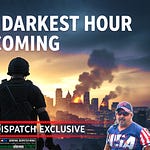BLUF MAIN TOPIC: What to Do in the First 24 Hours during and after a complex coordinated terrorist attack. It's all about critical decisions, not just gear. This is the "prepper doctrine" for surviving the first 24 hours after an attack.
When America faces a coordinated terrorist attack, your survival hinges on decisions made in those critical first 24 hours. While mainstream media downplays these threats, we must acknowledge the reality - our enemies are at our doorstep. Complex coordinated terrorist attacks (CCTAs) involve multiple targets, locations, and methods simultaneously, designed to overwhelm emergency services and maximize chaos.
The initial moments during an attack demand immediate action. Your priority must be situational awareness and rapid evacuation from danger zones. Forget the Hollywood heroics - your primary mission is surviving to protect your family. Communications will likely fail as networks become overwhelmed, so having predetermined rally points with loved ones is essential.
After the initial assault, government response will be chaotic and potentially inadequate. We've seen this pattern repeatedly. You'll need to make independent decisions based on limited information. This requires preparing your mindset now, establishing clear personal protocols, and maintaining operational security. Remember, in those first 24 hours, you're not just surviving the terrorists - you're navigating a landscape where law enforcement, confused civilians, and possibly follow-up attacks create additional dangers. The doctrine of first-day survival is about decisive action within chaos.
Keep reading below the banner...
DISCLOSURE: This post contains affiliate links. If you make a purchase through them, we may earn a small commission at no extra cost to you. This helps keep our work independent. Thank you for your support.
PRACTICAL TIPS | MAIN TOPIC
Preparing for a complex coordinated terrorist attack requires specific actionable steps that most preparedness experts won't tell you. First, create a communication blackout protocol with your family. When cell networks crash, know exactly where to meet and when. Set primary, secondary, and emergency rally points with specific timeframes - if someone doesn't arrive within 30 minutes, move to the next location.
Establish a "go/no-go" decision matrix now. During an attack, emotional responses cloud judgment. Have predetermined criteria for when to shelter in place versus when to evacuate. Keep a laminated card with these decision points in your wallet or purse.
Vehicle preparation is critical but often overlooked. Store your vehicle with enough fuel to travel at least 200 miles without refueling. Position it for immediate departure - backed in or pulled through parking spaces. Keep a paper map with multiple evacuation routes marked, avoiding likely terrorist targets and choke points.
Information gathering becomes vital. Have a battery-powered radio tuned to emergency broadcasts. Disregard social media rumors in those first hours. Document everything you witness with notes rather than photos or videos, which drain battery power you'll need for communication.
Finally, maintain a 24-hour ready bag separate from your long-term supplies. This isn't about survival gear - it's about movement, communication, and tactical decisions. Include cash, copies of identification, medical supplies for trauma, and minimal sustenance to keep moving.
LIMITED TIME OFFER Get 20% off your GUARDIAN membership FOREVER...
https://survivaldispatchnews.substack.com/20off
EXCLUSIVE CONTENT | MAIN TOPIC
What everyday Americans must understand about terrorist attack survival is that our government's response systems are designed for natural disasters, not coordinated enemy action on American soil. This reality demands personal responsibility and community resilience.
Begin by developing what military strategists call "tactical patience." The first wave of information after an attack will be wildly inaccurate. Make no major movements based on initial reports. Instead, wait for pattern recognition - are attacks continuing? Are they focused on specific infrastructure? This analysis should guide your next steps.
Community preparation becomes essential. Form neighborhood watch groups focused on terrorism response. Identify local veterans, law enforcement, and medical professionals who can provide leadership during crisis. Establish neighborhood communication systems independent of cellular networks, such as CB radios or runners.
Faith communities must step up as shelter and support centers. Churches historically served as sanctuaries during conflict, and they must reclaim this role. Work with your congregation to establish emergency protocols, stockpile supplies, and create systems to account for members during crisis.
Political action matters too. Demand accountability from elected officials regarding border security and terrorist threat assessments. Support legislation strengthening local emergency response capabilities. Remember that preparing for these scenarios isn't fearful - it's faithful stewardship of your responsibility to protect family and community.
When attacks come, Americans with preparation and clear decision protocols will become islands of stability in chaos. This isn't about surviving alone - it's about preserving the Christian values and constitutional principles that make America worth defending.
COMMUNITY SPOTLIGHT
Thank you Tim Smith for the best user submitted story yesterday "Afghan and Syrian passports are completely compromised - why won't our @StateDept treat them that way?": https://x.com/TPASarah/status/1957920766042992670
JOIN THE CRUSADE!
Help us save our republic & Christian culture by sharing our publication.
Email questions to Support@SurvivalDispatch.com
Godspeed,
Chris Heaven, CEO
Survival Dispatch















